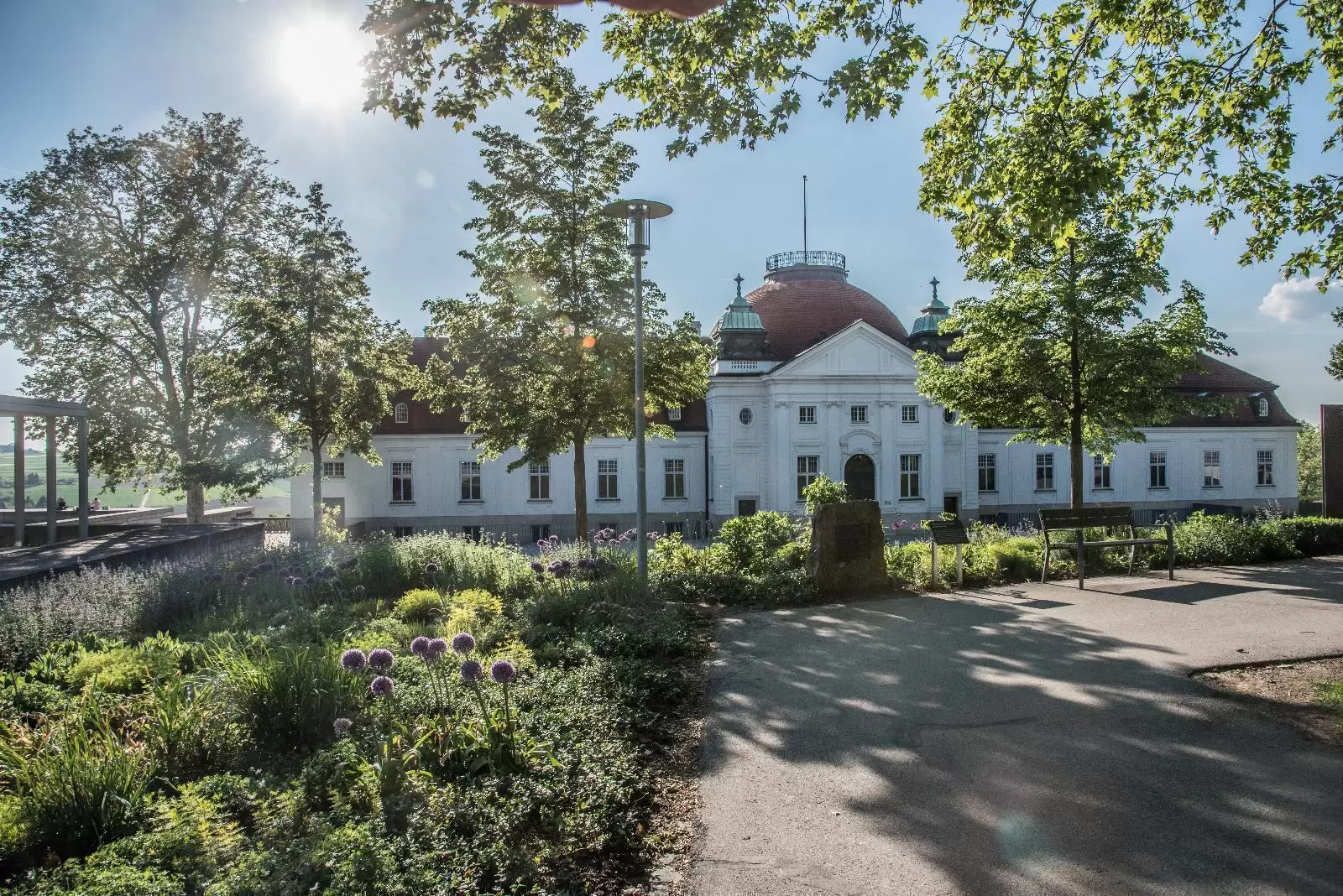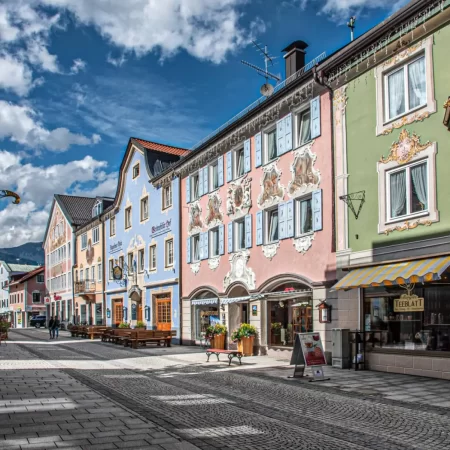The city of Schiller, Marbach am Neckar:
Where it all began
On the trail of Schiller & Goethe in Frankfurt am Main
Discover the favourite places of two great densities
Of course, Frankfurt am Main is not to be missed among the places of excursions related to Schiller and Goethe. Although both poets spent long periods of time in the city of Goethe’s birth, they never met there in person. One of the most famous memorials to the poets is certainly the house where Johann Wolfgang von Goethe was born at Großer Hirschgraben 23, which has been reconstructed as Goethe’s parents’ house fell victim to a fire. The Goethe House in Frankfurt brings the life of the family in the 18th century to life. You can admire original Goethe furniture in the poet’s room, such as his desk or his workbench. The neighbouring Goethe Museum Frankfurt also exhibits numerous paintings and documents by the famous Frankfurt native.
But where did Johann Wolfgang von Goethe mainly live? He lived in his parents’ house during his childhood and youth before being invited to Weimar by Hereditary Prince Carl August of Saxe-Weimar Eisenach in 1775. He then spent a total of 50 years here. Goethe’s famous works such as “Götz von Berlichingen”, “The Sorrows of Young Werther” and the original version of “Faust” are attributed to the Frankfurt phase. So it’s no wonder that Frankfurt am Main is often referred to as Goethe’s city. Schiller also tried his professional luck in Frankfurt a little later. After a few unsuccessful attempts, his plays “The Robbers” and “Cabal and Love” premiered in Frankfurt am Main in 1784 to much acclaim. Today, the Schiller Monument Frankfurt in the Taunusanlage as well as Schillerplatz and the neighbouring Schillerstrasse commemorate the famous German poet.
Excursion destination Gerbermühle Frankfurt
Recover like Goethe
The Gerbermühle has an eventful history behind it. Built in the 14th century, a grain mill was added around 200 years later and the building was used as a tannery. The later tenant Johann Jakob Willemer finally invited Goethe, probably the most famous guest of the house, in 1814. Inspired by the picturesque location of the Gerbermühle on the banks of the Main, the poet stayed for over a month during one of his later visits. Today, the Gerbermühle is home to a hotel and restaurant. In the middle of a green oasis, you can relax here and enjoy the view of the Frankfurt skyline from the idyllic terrace.
Buesing Park Offenbach
Historic & idyllic
Not far from Frankfurt am Main is another place where Johann Wolfgang von Goethe was often to be found: the Lili and Buesing Park in Offenbach. The idyllic park with its extensive lawns and old trees was laid out around 1700. The centrepiece is the Lili Temple, which was built by banker Johann Friedrich Metzler as a tea and bath house for his summer residence in Offenburg. There was a grotto in the basement with direct access to the Main. Today the temple serves as a gallery. Another highlight of Buesing Park is the Buesing Palais, where Goethe was once a guest. The poet is said to have courted Anna Elisabeth (Lili) Schönemann here in 1775. Today, a memorial with a poem commemorates Goethe’s visit to Büsing Park.
Experience Goethe & Schiller up close in Weimar
Immerse yourself in the world of poets
When travelling in the footsteps of Goethe and Schiller, you should definitely plan a visit to Weimar. The two poet friends spent several years here and worked together on various works as well as at the Weimar Court Theatre, where Goethe was the first artistic director and many of Schiller’s plays were performed. Today, the time of Goethe and Schiller in Weimar is recognised as the period of Weimar Classicism – this was further underpinned by the official UNESCO World Heritage title. It is not only the statues of the two famous poets on the square in front of the German National Theatre in Weimar that point to their time together in Weimar. Numerous places such as the Schiller House Weimar and Goethe’s home can be visited today. Friedrich Schiller spent the last three years of his life in his house until his death in 1805. Today, you can visit the living quarters and study in Schiller’s house as well as the adjoining Schiller Museum with visitor workshop. Even more present in the city is Goethe, who lived here until his death in 1832. His house on the Frauenplan with his study and private library provides an exciting insight into the poet’s life. In the Goethe National Museum, you can visit a permanent exhibition on Goethe’s life and work. The Duchess Anna Amalia Library, which was once run by Goethe for 38 years and was extensively restored after the devastating fire in 2004, is also well worth a visit. Another of Goethe’s legacies is the park on the River Ilm, which he helped to design, with the Roman House and Goethe’s Garden House, which you can explore on a leisurely stroll.
Schiller House & Goethe's Auerbach's Cellar Leipzig
Discover the historical places that Goethe and Schiller visited and inspired in Leipzig
Goethe and Schiller also spent time in Leipzig independently of each other when they were young. The Schiller House in Leipzig, where Friedrich Schiller spent the summer of 1785 at the age of 25, is a particularly interesting place to visit. In the small farmhouse in the Gohlis district, you can learn more about Schiller’s life in Leipzig, where he wrote his famous works “Ode to Joy” and “Don Carlos”, among others, as part of an exhibition. In summer, you can attend readings, concerts and theatre performances in the garden of the Schiller House. Johann Wolfgang von Goethe spent a little longer in Leipzig. He studied law here from 1765 and was a frequent visitor to Auerbach’s Keller (Cellar) during this time. The restaurant, which opened in 1525, is still located in the Mädlerpassage today. The famous restaurant was mentioned in Faust, one of Goethe’s best-known works. A statue was erected in front of Auerbachs Keller in memory of this special guest. Another Goethe memorial in Leipzig is located on the Naschmarkt in front of the Alte Handelsbörse. Johann Wolfgang von Goethe spent a total of three years in the city and celebrated a particular success here: his first novel was published at the Leipzig Book Fair.
Jena: A walk with Goethe & Schiller
A journey to the scenes of their inspiration and friendship
In Jena, you can literally walk in the footsteps of Goethe and Schiller – on a very special walking trail. Small bronze plaques on the street mark the route that the two men are said to have taken through the city to Schiller’s home in 1794. Friedrich Schiller spent a total of ten years in the city and was a professor at the university here. This is why the university bears his name today. He lived with his family in a house at Schillergässchen 2, which can be visited today. Just as worth seeing are Schiller’s garden house and the extensive gardens, which have been reconstructed according to the original designs. This is where the poet completed “Wallenstein” and worked on other famous works such as “The Maid of Orelans” and “Mary Stuart”. Schiller and Goethe are said to have often sat together at an oval stone table in the garden. There is a memorial to Goethe in the Botanical Garden in Leipzig. He lived above the park in the Insepektorhaus between 1817 and 1822. On the ground floor of the building, you can view memorabilia of Goethe’s life and work in Jena in two rooms.
Excited about our insider tips for Germany?
Get more creative travel ideas straight to your inbox! Subscribe to our newsletter and discover new, inspiring places in Germany every month.

